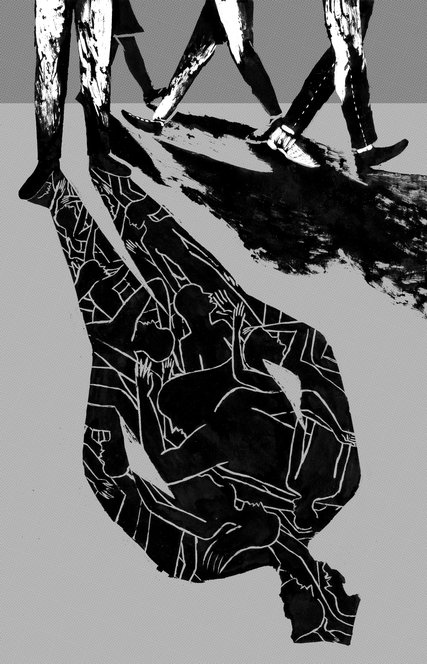
By Lydia Millet, NY Times, Opinion Pages
IN August 2010 John T. Williams, a homeless woodcarver of the Nuu-chah-nulth tribe who made his living selling his work near the Pike Place market in Seattle, was shot four times by a police officer within seconds of failing to drop the knife and piece of cedar he was carrying (Mr. Williams had mental health problems and was deaf in one ear). He died; the folding knife was found closed on the ground. The young police officer who shot Mr. Williams resigned, but he never faced criminal charges, even though the Seattle Police Department’s Firearms Review Board called the shooting unjustified.
In South Dakota in 2013, a police officer used his Taser to shock an 8-year-old, 70-pound Rosebud Sioux girl holding a knife; the force of the shock hurled her against a wall. After an investigation, the officer’s actions were deemed appropriate.
That same year 18-year-old Mah-hi-vist (Red Bird) Goodblanket of the Cheyenne-Arapaho tribes was killed by the police in his parents’ home in Oklahoma just before Christmas. They’d called 911 because their son was having a violent episode after a misunderstanding with his girlfriend. Before the police entered their home Red Bird’s father begged them, “Please, don’t shoot my son.” A few minutes later, the parents would count seven bullet holes in their son’s body — one in the back of his head. The exact narrative of the incident, which fittingly took place in Custer County, is in dispute.
In November 2014, also in Oklahoma, Christina Tahhahwah of the Comanche tribe died under suspicious circumstances while in police custody. Fellow inmates claim that jail guards shocked her with a Taser for refusing to stop singing Comanche hymns.
In December 2014, one day after attending a #NativeLivesMatter rally against police violence, Allen Locke, a 30-year-old Lakota man, was shot dead by the police in South Dakota. Mr. Locke had been holding a steak knife at the time he was hit by up to five bullets; the shooting was deemed justified a month later.
Most recently, in July, a 24-year-old Lakota mother of two named Sarah Lee Circle Bear died in a South Dakota jail of a methamphetamine overdose. Her death, which involved a two-hour time lapse between the first signs of physical distress and her transport to a hospital, got almost no national media attention.
All the victims were Native Americans, and they’re just a small sample of a systemic problem. American Indians are more likely than any other racial group to be killed by the police, according to the Center on Juvenile and Criminal Justice, which studied police killings from 1999 to 2011 (the rate was determined as a percentage of total population). But apart from media outlets like Indian Country Today, almost no attention is paid to this pattern of violence against already devastated peoples.
When it comes to American Indians, mainstream America suffers from willful blindness. Of all the episodes of police violence listed above, only the killings of Mr. Williams and Mr. Goodblanket received significant news coverage outside Indian circles, the latter only in an article for CNN.com by the Oglala Lakota journalist and activist Simon Moya-Smith. The Williams shooting, which was the subject of public outcry, was covered by a major local news site, The Seattle Post-Intelligencer, as well as by The New York Times.
One reason for Indian invisibility in the media may be low numbers; Native Americans and Alaska Natives in the country now total about three million, or 5.2 million if you include mixed-race individuals, compared with about 45 million African-Americans. Perhaps equally important, their population densities off the reservation tend to be low. They have a small urban presence; New York, with about 112,000, and Los Angeles, with about 54,000, rank first and second among cities with American Indian populations. Phoenix, Oklahoma City and Anchorage come next. About one-fifth of American Indians still live on reservations.
Economic and health statistics, as well as police-violence statistics, shed light on the pressures on American Indian communities and individuals: Indian youths have the highest suicide rate of any United States ethnic group. Adolescent women have suicide rates four times the rate of white women in the same age group. Indians suffer from an infant mortality rate 60 percent higher than that of Caucasians, a 50 percent higher AIDS rate, and a rate of accidental death (including car crashes) more than twice that of the general population.
At the root of much of this is economic inequality: Indians are the poorest people in the United States, with a poverty rate in 2013 that was about twice the national average at 29.2 percent — meaning almost one in three Indians lives in poverty. So it doesn’t come as a complete shock that members of these disadvantaged communities encounter law enforcement more often than, say, middle-class whites. But the rate at which native people die as a result of those encounters is nonetheless deeply disturbing: Though “single-race” Indians make up slightly less than 1 percent of the population, they account for nearly 2 percent of police killings.
There are many complexities surrounding Native American interaction with the dominant culture, whose Declaration of Independence refers to them as “merciless Indian Savages” and whose history of mass killings has taken a staggering social toll. But the fact is that today’s avoidable tragedies of oppressed Indian lives and troubled deaths remain far too often in the shadows.
At this moment, when black Americans are speaking up against systemic police violence, and their message is finally being carried by virtually every major news source, it’s time we also pay attention to a less visible but similarly targeted minority: the people who lived here for many thousands of years before this country was founded, and who also have an unalienable right to respect and justice.
